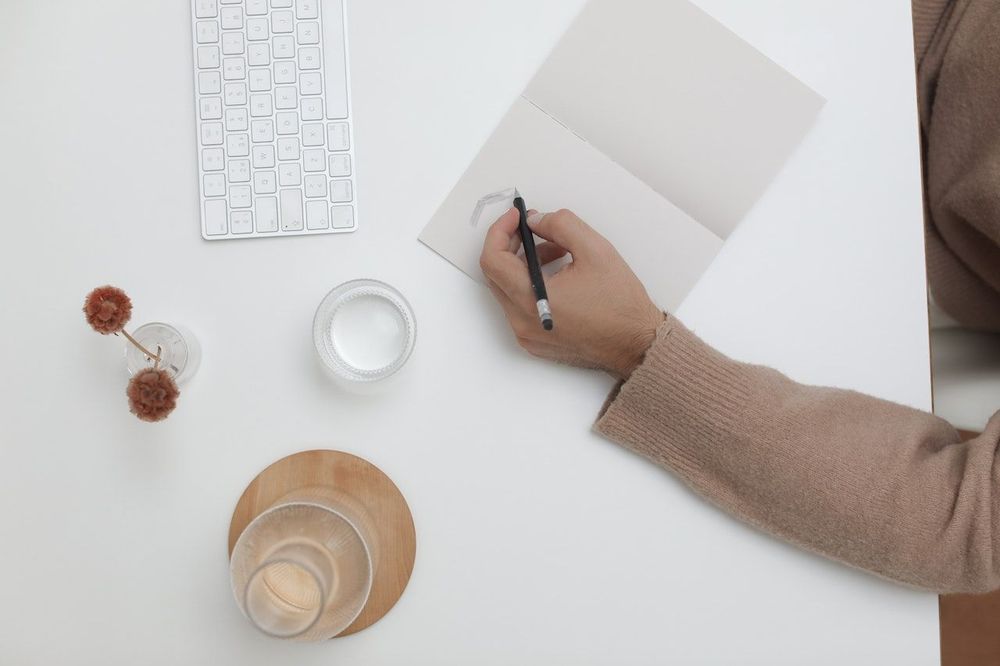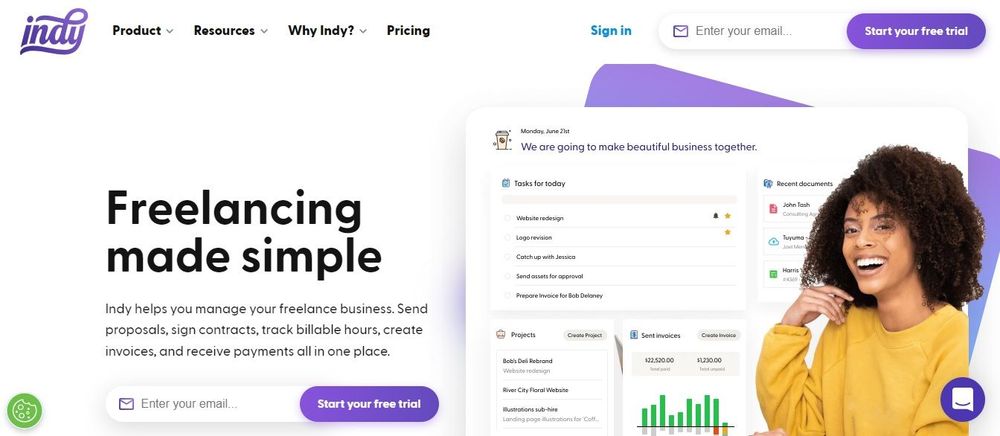A design brief is a detailed plan that communicates your design idea and allows you and your client to measure the project's milestones and process. Creating one to track your web design projects is vital to managing customer expectations.
Whether you've used them or not, you should consider incorporating them into every project process.
Here is everything you need to know about writing a design brief to keep your web design projects on schedule, be more structured, and impress your clientele.
What is a design brief?
A design brief, also called a creative brief, can aid in determining the size, scope, and critical components of your next project. The main distinction between a design brief and a proposal is that in a design brief, your customer has already chosen that they want to work with you. Since the deal is already sealed, it is time to lay out the specifics.
Putting the essential information in the design brief could be one of the best tools for managing your project. It can govern your project's workflow, from conception to completion, and inform design decisions. It can speed up the prototyping, design, and development processes and help you avoid possible problems.

Even though each designer and firm handles these briefs differently, working with your clients from the outset of a project will help. A design brief lets you set clear goals and objectives. You will also ask for feedback from your most important partners and hold each group accountable for the outcome.
Before starting any activity, prevent unneeded modifications and finger-pointing situations. That is, if you and your clients are both clear on your roles and expectations for the final deliverables.
Advantages of using a design brief
Other benefits for your project will result from commencing a project with a design brief. You and your client will gain the following advantages:
- Maintain individual contributors' focus while ensuring the project stays on schedule and budget.
- Gain a better understanding of the preferences and don'ts of your clients.
- Assures the client that you will stick to their objectives and engagement in the process.
- Equips designers with the knowledge, context, and foundation for visualizing a design.
- Paints a clearer picture of the client's expectations, enabling the fulfillment of the goal.
- Communicates all the design specifications upfront.
Why do freelancers need a design brief?
The design brief remains useful even after you've finished your project and handed it over. That is when it becomes resourceful for freelancers. You may use it as the foundation for a case study for prospective bids.
You don't have to start a new project from square one if your customer's projects are comparable and have repeating components. You can save resources by using the creative brief as a template.
Additionally, a distinctive design brief increases the likelihood of results being satisfactory. That is because it lowers the possibility of miscommunication between the client and the designers. It serves as the basis of the task and establishes the direction for the next design.
The client’s contribution captures their ideas and goals for the project. However, it's important to remember that the client and designer must work together to create a brief in the first place.
If you collaborate well, no one will ever leave the other to work on the project alone.
How to write a design brief
Design briefs can look different and have differing information depending on the project and the client. Here is a list of its most important aspects to help you structure a good document:
- Professional profile
- Project's description
- Project's objectives
- Intended audience
- Design specifications
- Plans and expenditures
1. Professional profile
A professional profile ensures that every team member understands your brand, your clients, and any other factors that could affect how the project turns out. This section should include the following items:
- The company details like the client's name and the product lines
- Unique selling proposition or brand differentiator
- Mission, vision, values, and messaging for the brand
- Important partners, contributors, and influential contacts within the company
- List of competitors, both direct and indirect
Include this critical data about your client's company, decision-makers, and background information. It will enable you to know your clientele from a brand perspective. It also allows you to know who is in charge of certain deliverables and who to talk to if there is a problem.
You might have already researched your client and pitched your services to them, which led to them hiring you. If so, you can use the information you've gathered. Ensure your client checks the brief for correctness and adds anything you may have missed.
If your client hired you for the project, they should be the ones to tell you about it. Remind them, so they know it's their role to convey this information.
When engaging a bigger team, you should also recognize who in their company has the final authority on the project. This ensures that everyone is responsible, and it also makes the client relationships stronger.
During the launch, take the time to acquaint your associates and their team. Don't forget to ask relevant questions since it's an opportunity to air your concerns. Include all the relevant information in your brief, depending on your needs.
2. Project's description
In the project description section, deliver a detailed description of the design brief. You can ask your client about this section of the brief at a convenient time. Your overview should clarify what the project is about, its scale, and the outcomes.
Here are examples of questions you can put in your template to ensure you're always on top of your game:
- Do you want to change something that already exists?
- Are you creating a new item?
- What do you think could be the hurdles?
- What have I not included in the project's scope?
- What other resources do you hope to acquire when the task is done?
Since you understand their expectations, you need to learn what motivates them to undertake the task. Attempt to answer this question by figuring out your client's issues with web design that made them recruit you. Probing the "why" can sometimes lead to alternative ways to fulfill your client's needs.
3. Project's objectives
Your business might focus on designing websites, but a website is the main business for some clients, especially those in online retailing. Use statistics or plain terms to explain what your project can achieve. Goals show the main idea of your project, while objectives are the smaller, more specific steps that, when done correctly, help you reach the goal.
Say the work's goal as briefly and clearly as possible. It may help with many marketing goals, but having one clear goal for the brief is very effective. Most goals are about change, so use language that moves.
Does it entail changing how people think or act from X to Y? Is it to reach a new, specific audience? Be honest about the potential results of your work. The goal of the entire marketing strategy, not design work, is to boost sales or market share.
After including your goals and objectives in the design brief, you can shift focus and figure out the technical steps you must take to reach them. Setting goals and objectives beforehand will guide well-thought-out decisions about your design. It will also show the client that your business' value goes beyond how the website appears.
That will make you trustworthy, thus improving your relationship with the client.
4. Target audience
No matter how good your pitch, your pursuit will be pointless if you don't have a target. It's the same with a design strategy: If you don't know who you're trying to reach, your message will be all over the place and go nowhere.
It is essential to ask your client who the project targets so that you can design your message with a clear picture in mind. Research extensively about the demographic that will be using your client's website. Knowing who your client wants to reach will help you make informed decisions.
Your client should have information about who they want to reach and be willing to share it with you. Remember, not every business owner will know these things. If this happens, take the initiative to bring your skill sets on board. As a show of commitment to the project, take the chance to offer research services.
If your client isn't interested, ask about their ideal customer demographic and create a marketing persona. Your persona should have demographic data, like age, gender, and location, and psychographic information, such as habits and interests. That data can inform you about what your potential clients prefer.
If your client has a website, you can get demographic and psychographic information from Google Analytics reports that use new segments. It's a fantastic place to begin if your client isn't sure who they want to attract to their online store. Your client might find that the people who go to their website aren't the people they want to reach.
5. Design specifications
Include all the vital information in this section, so you don't have to make any changes or keep asking your client for files of the right size. Giving your team detailed instructions in your design brief will give them everything they need. As a result, they will work well and fulfill the client's expectations.
Including these details also minimizes the likelihood of having to make changes or start over from scratch. Even though each project could have diverse needs, you can add some of the details provided below about your deliverables:
- Dimensions of design elements
- File formats
- Required color scheme
- Image assets
- Relevant documents
This section also serves as a good spot to put any reference material. These might include brand guidelines, mock-ups, mood boards, and anything else that could help complete the project.
You may work more closely with your client on this project stage, especially if they will be creating design elements like graphics while you're creating the website.
Lastly, communication is key at this stage. Provide detailed information in the design brief to ensure a seamless process.
6. Plans and expenditure
When working for an agency, it's easy to delay worrying about finances and deadlines until you're dealing with clients. Still, these project factors are just as important to your creative colleagues as they are to your colleagues in account services. Freelancers must resolve them at the early design stage.
- The project's budget
If you know about your client's project budget, you can manage their expectations and your team's schedule well. During your first meeting, brief your client about the project's scope and budget for all research disciplines. This will increase the likelihood of efficiency and avoid scope creep.
If you don't have a clear budget, you or your team might lose track of how many billable hours you've logged. Use any app that tracks time to keep track of time and stay within the project's budget. If you don't consider the budget, you might come up with a campaign that is too expensive to run, forcing you to go back to the drawing board.
- The project's schedule
To keep project costs low, you must stay on track and deliver to the client on time. That is why your design brief must include a schedule. It should be reasonable and provide for anticipated adjustments and unforeseen obstacles.
You might want to promise to finish a project in a short period, but this is usually a bad idea. Give your workback plan some room for change so that you can deal with problems that come up before your next milestone. Your team won't have to work longer hours and get back on schedule without rest.
A good plan should list important steps along the way, not just the final deadline. Your team must estimate the delivery dates for concepts, designs, development work, and reviews. A work schedule helps keep your team on track and gives your client an idea of how the design process works.
When drafting a design brief, it is, thus, essential to establish reasonable expectations.

Do’s and don’ts of a design brief
Do’s
- Ensure everyone who needs to know can see the final design brief before work begins.
- When compiling the data, be as specific as possible. Instead of crafting an elevator pitch, try crafting a warm explanation.
- Offer as many visual examples as possible. What do you like about yourself, and what do you dislike about yourself? Provide justifications for both of these aspects.
- Tell the designer about any sector-specific requirements they must meet.
- Include a backup plan in the design brief. That covers delays in the schedule and the creation of any new assets that may be required.
- Make a new design brief for every project or advertising drive you launch. If the campaign is big and needs different visual assets, divide the brief into subheadings. Perhaps a group of designers, rather than just one, is what you need.
Don’ts
- Never leave out crucial details in the design brief.
- Don't assume that a single designer can handle numerous projects at once.
- Don't assume the designer can read your mind; communicate your needs.
- Don't shy away from meeting the designer face-to-face. Any design project needs to have a meeting, either online or in person, to succeed.
- Don't assume everything will go as planned; you may need to make adjustments so that the final product meets your standards.
Guidelines for writing a creative brief
Aside from the major parts of a design brief we've already talked about, here are some tips for writing a thorough design brief:
- Work with other design experts. A design project often necessitates a collaborative effort. Working with a design team could help you figure out a good time frame for making a design. You may also consult with financial experts to establish the project's budget.
- Create an example of a design brief. Look for design models with the qualities you value and use them as inspiration for your own. If your work is already available to clients, the design team will enjoy seeing examples of your current brand's visuals, such as typefaces, colors, or photographs. Provide models that you believe are a good fit, even if they borrow from the designs of your primary competitors. You can measure up to your standards if you do this. Communicate to the designer your displeasure with some elements. That will give them a sense of your preferences and help them deliver results you'll be happy with.
- Draft a template of a design brief. Before starting a project, you should refer to an ideal template for important elements. The template can form the basis of your design brief questions.
- Make the brief easily accessible. Consider posting these documents in central office areas if you write them on paper or a board. You might also send them as attachments to relevant parties via email. Following this step can help in your project monitoring efforts.
- Conduct market analysis. Examine the market to see how other providers are performing. By researching the client's competitors, you can make better design decisions.
- Research about branding. Observe the feedback of clients of other agencies. It will help you to identify parts that will be important for the design task.
- Assess market reports. It is the easiest way to tap into a wider feedback loop. That is how you know what other customers want and need.
Conclusion
To launch a project, you must have a well-written design brief, regardless of whether you are an individual or part of a large group of experts. They save you time and resources and are also a document you can refer to when the client begins to change their mind about the project's direction.
A creative brief is the first link you have to a new project. The stronger this link, the better the project will turn out.

Now that we’ve covered everything about design briefs, it would be handy to point you in a certain direction. Wouldn't it? You can use Indy's Forms tools to make a design brief from scratch. Indy will help you plan tasks, make beautiful documents, keep track of time, and send invoices to your clients. Isn't such convenience what we all need? Get started today for free.
FAQ’s
What makes the brand stand out?
These are examples of factors that will contribute to giving the brand identity. These questions should guide the designers throughout the process. For instance, does the client seem courteous, fancy, techy, or friendly? Should they strive for a confident, authoritative persona or a kind, approachable one?
When it comes to color, what does the client want or dislike? Maybe they don't want to look like everyone else, so they don't use blue and green, which are usually associated with the opposition. Knowing that the general manager dislikes pink is also useful foreknowledge. You could inquire about their preferred typefaces.
Regarding font, consider using both serif and sans serif fonts and script fonts. Should I choose a more serious, formal font, and does the customer like that? Or do they like handwritten cards with scripts that show a sense of playfulness and warmth? You can use it to determine the mood of the design elements.
Who’s the competition?
Knowing your product's primary competitors and unique selling proposition is also beneficial. The design should show what makes it unique to differentiate the brand from its competitors.
It is helpful to define the competition to understand the industry better. It also helps clarify the approach so that the designer can make smart decisions about how to stand out from the competition.
Ask your clients how they plan to stand out from the crowd for better results.
What is the use of the design brief?
The design brief puts the designer's ideas, research, and conclusions into a complete, easy-to-understand document. It is then shared with the rest of the team for development.
During the design handoff meeting, the design brief is a document passed off to the rest of the team. It's part of a bigger meeting where the goals, sources of inspiration, and vision for the season's collection are discussed.
Why is it important to learn how to draft a design brief?
Knowing how to write a design brief is critical as it directs future design projects. It comprises a project's objectives, scope, and strategy, directing your workflow and decision-making.
You can also use these components to check your contract with clients about the project's deliverables, budget, and timeline. Regardless of your livelihood, these files can help you structure design projects.
Design briefs are also a good way to judge how successful a design is. For instance, clients may compare your product design to the deliverable you specified in the brief. As a design project proceeds, it may become necessary to modify the included information. Ensure that the design brief you create aligns with your project's objectives.

What kind of projects use design briefs?
Design briefs are used widely, and you may observe them in many contexts. Some of these projects include:
- E-commerce
- Branding
- Architecture
- Web design
- Interior and fashion design
Your design brief will likely find applications in a wide variety of fields. For instance, designing anything beyond a blank canvas, whether a package or a web page, requires a design brief.
How long should a standard design brief be?
The length of a design brief will vary depending on the client and the project. It sounds like a cop-out answer, but design assignments vary in size and scope. The length of different design tasks varies so much that it's impossible to give a word count that works for everyone.
Which format is ideal for a design brief?
Use a format that best matches your brand and your client's image for the design brief. Some briefs have a corporate feel, and some are miniature works of art.
You may even create a presentation or write it up in Microsoft Word. Again, the brief's ability to make people think and talk is more important than how it looks.



